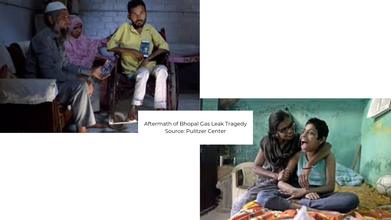- Health Conditions A-Z
- Health & Wellness
- Nutrition
- Fitness
- Health News
- Ayurveda
- Videos
- Medicine A-Z
- Parenting
3 Ophthalmologist-Approved Ways To Refresh And Relax Your Eyes Once A Week For Strong Vision

Credits: Canva
We stretch our legs after a long flight, we roll our necks after a day at the desk, we even calm our minds with meditation and journaling. But when did you last actually give your eyes a break? In a world where we increasingly exist in a digital-first space, where most of us are glued to screens from sunrise to sunset, our eyes are working behind the scenes to take the strain. And yet, we scarcely ever consider looking after them.
How often do you ever really pay attention to your eyes—until they burn, blur, or just plain tire? If you're like most of us in today's screen world, I'd bet my paycheck that your eyes work overtime day and night. From the moment we wake up and reach for our phones to the all-night binge-a-thons and Zoom-a-thons, our eyes barely get a chance to rest at all.
So, what if you could take only 15 minutes a week to rest and refresh your eyes—and actually feel the difference? Let's take a look at three easy, expert-recommended ways to spoil your peepers.
The truth is, your eyes are working double time—and they're footing the bill. Eye strain, dry eyes, blurred vision, and even headaches are part of our daily narrative. Based on a survey conducted by All About Vision, remote workers now spend nearly 13 hours a day in front of a screen. Given such exposure, it's no wonder that nearly half of the study participants reported a deterioration in their vision over the past two years.
So, what do you do to fight against this visual exhaustion? As leading ophthalmologist Dr. Neeraj Sandhuja says, "Our eyes are under more stress than ever before. With screen time at night, Zoom marathon meetings, and endless scroll, the visual system is constantly bombarded. Giving your eyes one dedicated day to reboot can be a huge payoff."
Here's a look at three expert-approved techniques that can help refresh your eyes, improve focus, and aid strong vision in the long run. All it requires is one committed session a week.
1. The Rule of 20-20-20
If your work today consists of hours and hours of typing on a computer, this easy but powerful strategy can become your greatest friend. It's known as the 20-20-20 rule: Check your vision at 20 feet away every 20 minutes, for 20 seconds.
This short break allows your eye muscles to unwind, interrupting the constant stream of near-work tension. Dr. Sandhuja explains, "Staring at screens all the time keeps your eyes in one position, taxing the ciliary muscles that do the focusing. The 20-20-20 rule gives your eyes some relief from time to time, avoiding chronic fatigue."
Think of it as a micro-break that recharges your visual batteries. Whatever you're gazing out the window, at a plant across the room, or just gazing off into space, you're giving your eyes a chance to breathe and recharge.
2. Practice Palming
This ancient yogic exercise is older than the hills and a simple way to relax and rejuvenate tired eyes. You don't even have to borrow your neighbor's hands – just your own two. Take a few minutes alone.
Start by rubbing your palms against each other strongly to heat them up. Once they are heated up, gently position them over your closed eyes—without pressure. Let the heat and darkness blanket your sight. Hold on like this for a minute or two, breathing deeply.
“Palming not only reduces eye strain but also relaxes your nervous system,” shares Dr. Sandhuja. “It’s a form of sensory withdrawal, helping your mind and eyes retreat from constant stimulation.”
The experience is meditative and grounding. And best of all, it requires no special equipment—just the intention to rest and rejuvenate.
3. Eye Circles and Blinking Exercises
Just as stretching loosens tight muscles, eye movement relaxes tension around the optic nerves and boosts circulation.
Practice this mini routine:
- Slowly rotate your eyes clockwise for one minute, then in reverse direction.
- Then rapid blinking—blink as fast as you can for 10 seconds.
These movements trigger natural lubrication and the tear glands, so they're especially beneficial if you have dry eyes. "Eye movement exercises promote flexibility and coordination between the eye muscles. They also promote tear flow, which is essential in combating dryness due to prolonged screen use," explains Dr. Sandhuja.
Use these as your weekly visual yoga— gentle but powerful.
Make It a Weekly Ritual
Consistency is the key. Select one evening of the week—Sunday evening or a mid-week wellness break—to take 10 to 15 minutes to do these eye-care rituals. Do it consciously. Have a candle lit, soothing music playing, and treat it as an non-negotiable aspect of your wellness routine.
Over time, this habit will pay off. You’ll notice reduced eye strain, improved focus, fewer headaches, and an overall sense of calm. Just like your body benefits from rest and recovery, your eyes thrive when given a chance to recharge.
Though these exercises won't fix refractive errors such as myopia or astigmatism, they can significantly enhance visual comfort and concentration, particularly in the age of hyper-connectivity. From palming and blinking to gazing at the distance, every method enhances your eyes' inherent capacity to relax and rejuvenate.
As Dr. Sandhuja so aptly puts it, "Don't wait for discomfort to remind you to care for your eyes. Make it a habit, and your future self will thank you." So do it—go ahead and arrange that weekly eye-care appointment. Your eyesight is worth the care.
Dr Neeraj Sandhuja is a Ophthalmologist, Founder and Director of Viaan Eye and Retina Centre
Ozempic Users In 2025 Reported These 5 Unusual Side Effects

Credits: Canva
From celebrities trying to slim down for a red-carpet event to people using medication to manage diabetes or obesity, GLP-1 drugs have become a widely used choice for weight control. They are often described as near-perfect solutions, yet they can bring unexpected effects. In 2025, many users began noticing reactions that had not been mentioned before, especially among those taking Ozempic. If you rely on Ozempic for weight management or overall health, it helps to know the unusual side effects people spoke about during the year.
What are GLP-1 Drugs?
GLP-1 drugs, also known as GLP-1 agonists, were first developed for diabetes care. They work much like the body’s own GLP-1 hormone, which is released after meals to prompt insulin production. Those living with diabetes often do not make enough insulin to keep blood sugar steady. A GLP-1 medication boosts insulin release so blood sugar stays more stable. These drugs often support weight reduction as well.
For many people with diabetes, weight control plays an important role in managing the condition. GLP-1 drugs reduce hunger and help the stomach empty more slowly, creating a longer sense of fullness. This can lead to marked weight loss in people with or without diabetes.
Ozempic: What Is It And How Does It Work?
Ozempic is a prescribed treatment mainly used for adults with type 2 diabetes. The active substance is semaglutide, given once a week through an injection. It is a glucagon-like peptide-1 (GLP-1) receptor agonist that acts like a natural hormone in the body. It increases insulin when blood sugar rises, lowers glucagon levels, and slows the movement of food through the stomach, which in turn reduces appetite.
5 Unusual Side Effects Of Ozempic People Reported In 2025
Beyond the familiar effects such as nausea, constipation, and stomach discomfort, some users shared experiences that felt different from the typical list. Below are the unusual reactions connected with Ozempic that gained attention in 2025.
Ozempic Vulva
“Ozempic vulva” is a phrase women have used to describe changes in the vulva, including loss of volume, sagging, or dryness, especially after major weight loss linked to Ozempic or similar medicines. These changes are not a medical diagnosis. They seem to come from rapid fat loss, reduced muscle mass, shifts in hormones, or dehydration, rather than the drug itself, according to Healthline. Reported changes include a less plump appearance in the labia majora, dryness, and a looser texture.
Ozempic Poop
Medical News Today notes that Ozempic often triggers what is known as a “stool reflex”, in which the gut tries to clear space once food reaches the intestine. In some people, this reflex becomes unusually strong, leading to diarrhea. Many users have discussed this on Reddit. One person created a widely shared thread asking, with complete honesty, for tips on avoiding accidents while sleeping. They explained they had struggled with this for months and called it their most frustrating symptom. Another user, after three doses, said that “sh*tt*ng the bed” was the one thing they were dreading.
The good news is that most people do not face such long-lasting trouble. Studies from 2022 show that diarrhea linked with Ozempic usually lasts around three days when starting the drug. For most users, it settles within about four weeks as the body adapts.
Ozempic Breasts
“Ozempic breasts” is an informal expression used for changes in breast size or shape that appear after rapid weight loss while on Ozempic. Breasts contain a large amount of fatty tissue, so when someone loses weight quickly, they may notice less fullness, sagging, or a flatter look. Although this is not a recognised medical term, it has become a common concern among those using the medication, according to Healthline.
Ozempic Butt
“Ozempic butt” refers to loose or sagging skin that may show up after dramatic and fast weight loss while using these drugs. This can cause a softer or deflated look in areas where people naturally hold more weight. It is important to remember that this effect comes from rapid weight loss and not from the medication acting directly on the body.
Ozempic Feet
“Ozempic feet” is a name people have given to changes in the feet linked with sudden weight loss from drugs like Ozempic. These include loose skin, reduced fat padding, more visible veins, and extra pain while walking. These shifts can make the feet more sensitive and increase the chance of developing corns and calluses, since there is less cushioning. Other possible concerns include tingling, numbness, or swelling, as noted by Healthline.
If you notice any of these changes, remember that they often appear during periods of fast weight loss. Still, it is best to speak with your healthcare professional if anything becomes difficult to manage or feels out of the ordinary.
Health Impact That Still Lingers On The Victims Of Bhopal Gas Tragedy That Released 40 Ton Of Toxic Gas In Air

Credits: Wikimedia Commons
In June 2025, 337 ton of toxic waste from the Union Carbide factory in Bhopal finally left from the city in 12 trucks and arrived at the Pithampura industrial area. The waste was carried in spill-free trucks, but the impact of this toxic waste and the toxic gas on people, still spills today.
As we observe the National Pollution Control Day today, which commemorates the victims of the 1984 Bhopal Gas Tragedy, we also look back onto how its spill on human lives.
Also Read: Trump MRI Results Released: Heart and Abdomen Scan ‘Perfectly Normal’, White House Says
What Happened On December 2 and 3, 1984?

Between December 2 and 3, around midnight, in 1984, there was a massive leak of a poisonous chemical methyl isocyanate (MIC) from a Union Carbide pesticide plant that took thousand lives, and maimed a thousand more, leaving many, even four decades later, impacted.
As per the 1992 study by R Dhara, the gas leak caused chronic inflammatory damage to the eyes and lungs, which was also the main cause of morbidity. Reproductive health problems in form of increased spontaneous abortions and psychological problems were also reported.
The leak was called world's worst industrial disaster. Around 40 ton of toxic methyl isocyanate gas was released into air, and killed more than 3,000 people.
Also Read: Scromiting: What Is This Severe Vomiting Syndrome Linked To Long-Term Cannabis Use
Those Who Are Still Affected

The toxic waste which had been lying till June this year, as per surveys, contain 6 of the persistent organic pollutants that are banned by the United Nations for their highly poisonous impacts on the environment and human health.
As per the data by the Sambhavna Trust, even after 3 decades, the mortality rate for gas-exposed victims is still 28% higher than the average. The survivors are twice as likely to die of cancers, lung diseases, and tuberculosis. They are also three times as likely to die from kidney diseases and 63% more likely to have illnesses. The data also showed that a 25% of the survivors who had been exposed to the gas were under-active thyroid and can have long-term health impacts.
The explosion also had adverse effects on women, babies, and caused a high rate of infertility, stillbirths, abortions, early menopause and irregularities in menstrual cycles. The Guardian reported that many women left their husbands as they believed "not to be capable of fulfilling the familial duties expected of them".
The Chingari Children's Centre which was established for those born with disabilities due to the gas tragedy registered over 1,000 children. Many of these kids were affected by cerebral palsy, muscular dystrophy, autism, intellectual disabilities, and severe learning difficulties.
A study by the Indian Council for Medical Research (ICMR), found that still 9% of babies who were born between 2016-17 had birth defects. These babies were born to mothers who had been exposed to gas. The Guardian reports that the "study was subsequently discredited by the ICMR, who ordered it not to be published or disclosed."
The Leak That Leaks Even Today

Last year, in September, survivors of the tragedy also visited Harvard TH Chan School of Public Health and shared their stories. The survivors included two women who were children when the gas leak happened, Farhat Jahan and Bati Bai Rajak. They shared that the disaster still continues to leave its impact on the new generation.
A 2023 study published in journal BMJ One also revealed that even after four decades of the tragedy, future generations are afflicted by disabilities and cancer. The study also noted a decline in male births a year after the tragedy, impacting around 100km radius around Bhopal.
Other health conditions include respiratory, neurological, musculoskeletal, ophthalmic, and endocrine issues. The impact also resulted in a 4-fold increase in miscarriages and a higher risk of stillbirth. Researchers from the University of California San Diego also noted that reproductive health impacts could trickle town to future generations, which could be seen even today.
Gordon McCord from the School of Global Policy and Strategy at UC San Diego and the author of the study said that male fetuses are more suspectable to adverse shocks including smog, disease, natural disasters and stressful events during pregnancy. This was reported in media outlet Down To Earth.
Studies also found that men born in 1985 within the 100 km of Bhopal had eight-fold increased risk of cancer.

Another study which analyzed the survivors from 1985 to 1994, titled Health Effects of the Toxic Gas Leak from the Union Carbide Methyl Isocyanate Plant in Bhopal noted for genetic risk of pregnancy outcome in women who were exposed to the toxic gas. The abortion rate was 523 per 1000, immediately after the tragedy. The study also found that infants were born with congenital malformations.
Bhopal gas leak tragedy paved way for a safer workspace and lead to the many laws which aims to protect the survivors, their rights, and also holds the companies accountable for the damage. However, despite this, many survivors still continue to live with chronic pain, diseases, and scarred memories from the tragedy.
This day observed as the National Pollution Control Day is a reminder to why environmental safety is key to health safety, and must alarm the nation for the air pollution situation that continues to worsen by every passing day.
What Is 'Ozempic Poop'? The Brutal Side Effects Failing People's Gut

Credits: iStock and Canva
Lots of new developments around weight-loss drugs, with the World Health Organization now stepping in to lower the dosage, and many companies like Eli Lilly actually slashing down the price for better access. Amid this what people may be forgetting are the unusual side effects of being on popular weight loss drugs.
The internet has made room for a lot of unusual confessions, but few are as chaotic, or as oddly supportive, as the Reddit threads where people taking weight-loss jabs like Ozempic and Wegovy openly discuss their most embarrassing side effects. And one theme keeps popping up: unpredictable bowel movements, including the dreaded “sleep sh*ts.”
One Reddit user started a viral thread with a painfully honest plea: “Any advice for not sh*tt*ng in the bed while sleep?” The user said they’d been dealing with this for months and called it “the most annoying side effect.” Another person, already three shots in, nervously listed “sh*tt*ng the bed” as something they were “not looking forward to.”
This mix of diarrhea, constipation, and everything in between has sparked concern, and, for many, shame. But as more people turn to GLP-1 medications for weight loss, understanding why this happens has never been more important.
Pooping Uncontrollably: It Happens More Often Than You Think
The phenomenon isn’t limited to anonymous Reddit users. A Florida nurse, interviewed by Business Insider, described weeks of constipation so bad she tried “everything from stool softeners to a megadose of Milk of Magnesia.” But by attempting to “hit it from the top and bottom,” she ended up losing control altogether, hence her reluctant membership in the self-appointed “sh*t the bed club.”
Another semaglutide user confessed online: “I quite literally sh*t myself while sleeping… tough few days of diarrhea after my first injection.” And yet, others reported the opposite: stubborn constipation, going days without relief, or passing what one Redditor bluntly called “rocks.”
These extremes highlight one thing clearly, digestive unpredictability is surprisingly common.
Why Do GLP-1 Drugs Mess With Your Gut?
Semaglutide (the active ingredient in Ozempic and Wegovy) is part of a class of medications called GLP-1 receptor agonists. These drugs work by slowing gastric emptying and nutrient absorption so users feel full for longer. But the same mechanism that makes the drugs effective can also confuse the digestive system.
Medical News Today notes that Ozempic often triggers a “stool reflex”, when food entering the gut prompts the colon to clear space. For some people, this reflex becomes unusually strong or overactive, leading to diarrhea.
On the flip side, slowing the gut too much can cause constipation. That’s why Wegovy’s own prescription info reports both diarrhea (30% of users) and constipation (24% of users) during clinical trials.
New York gastroenterologist Dr. Eric Goldstein told Insider that while digestive issues are a known side effect of GLP-1 drugs, the severity seen in social media posts is likely exaggerated because people tend to share the worst-case scenarios. Still, he emphasised that “any medication… may have changes or side effects that need to be monitored.”
How Long Does It Last — And Should You Be Worried?
Fortunately, most people don’t deal with weeks of chaos. According to 2022 research, Ozempic-related diarrhea typically lasts around three days after starting treatment. For the majority, symptoms settle within the first four weeks as the body adjusts. Only 4.3% of people stopped treatment because of GI side effects.
However, flare-ups are common after dose increases, and doctors may recommend slowing dose escalation or adjusting timing if symptoms become disruptive.
Still, experts consistently advise the same thing Reddit does, though with less sarcasm: monitor your symptoms, stay hydrated, avoid greasy or heavy foods, and reach out to your doctor if things become severe or last longer than a few weeks.
© 2024 Bennett, Coleman & Company Limited

